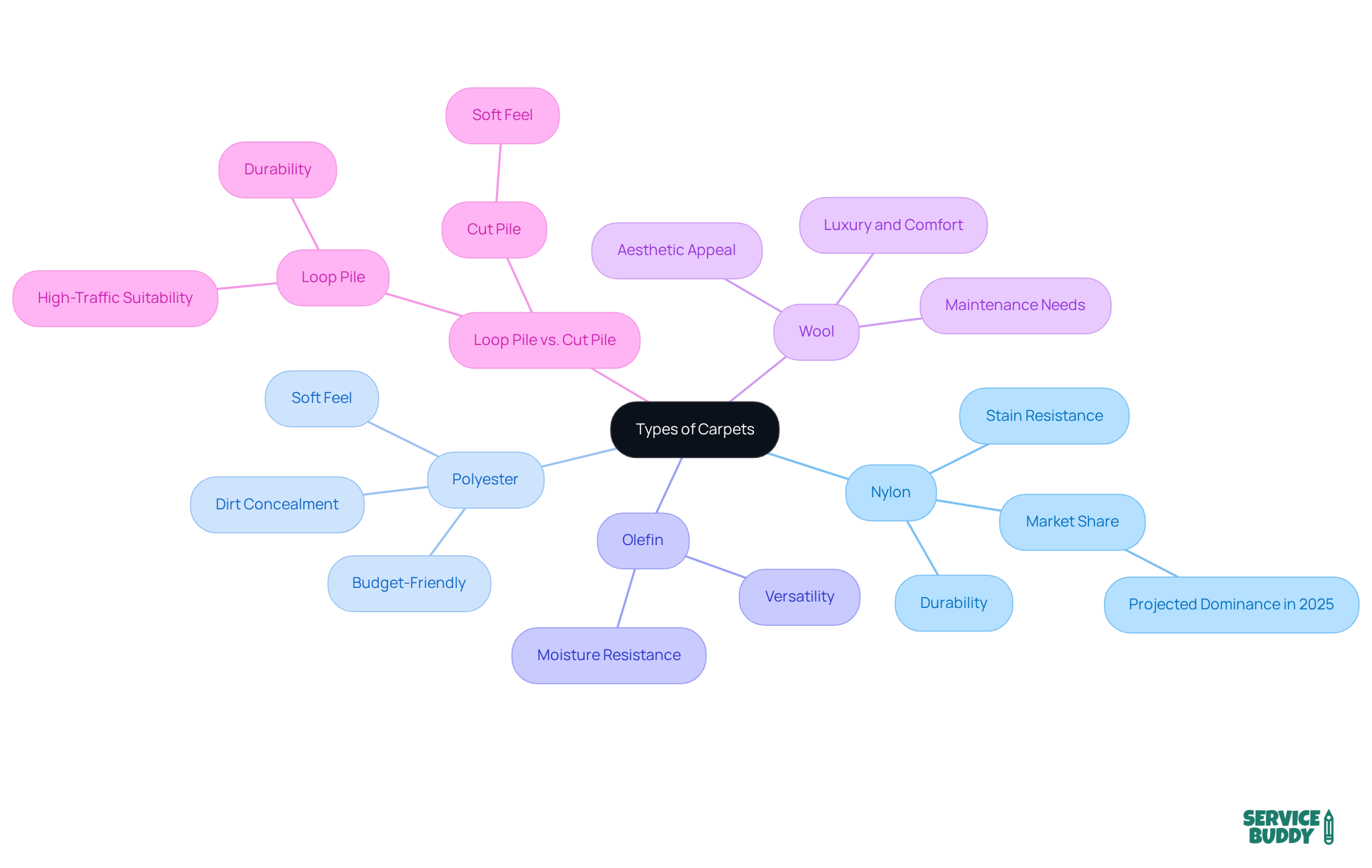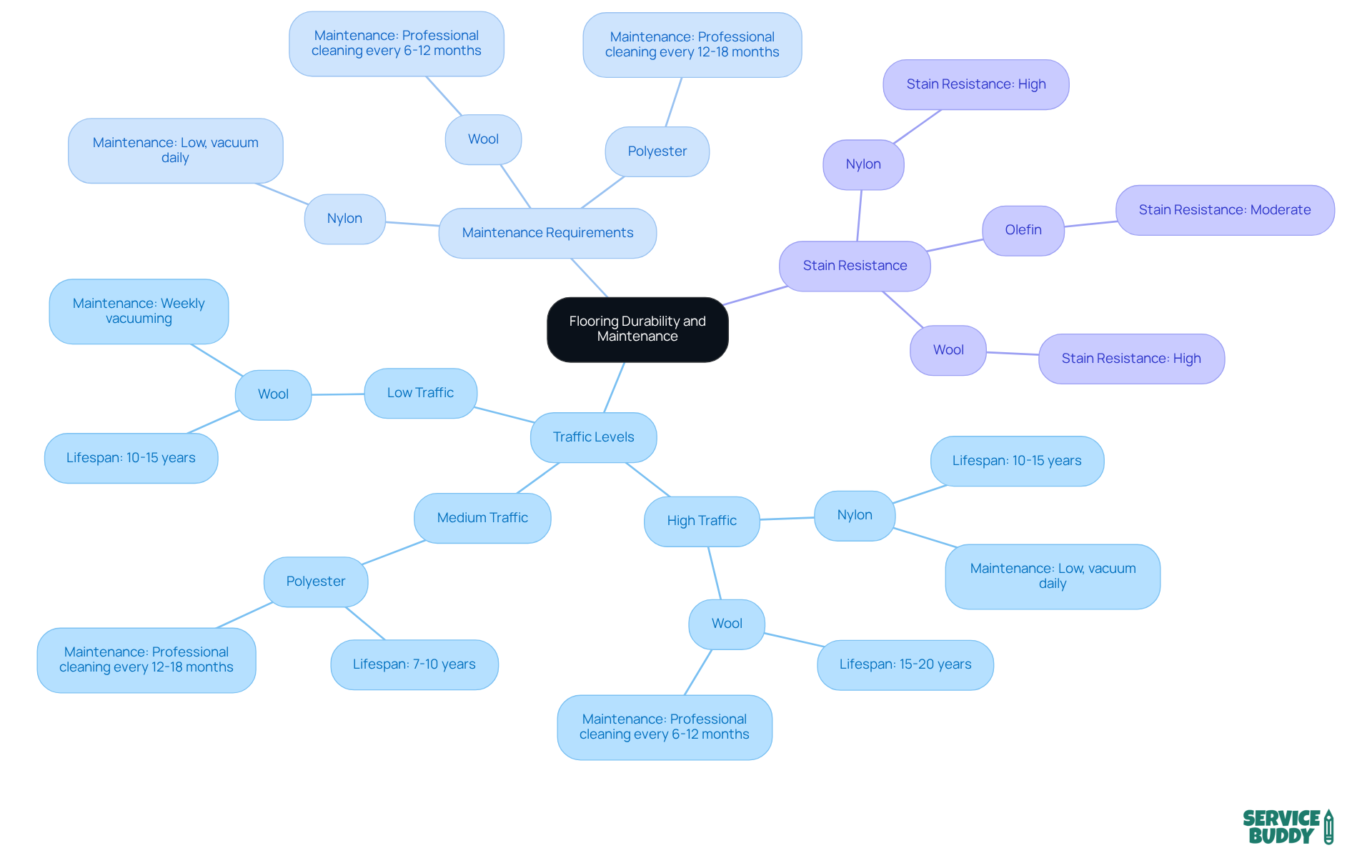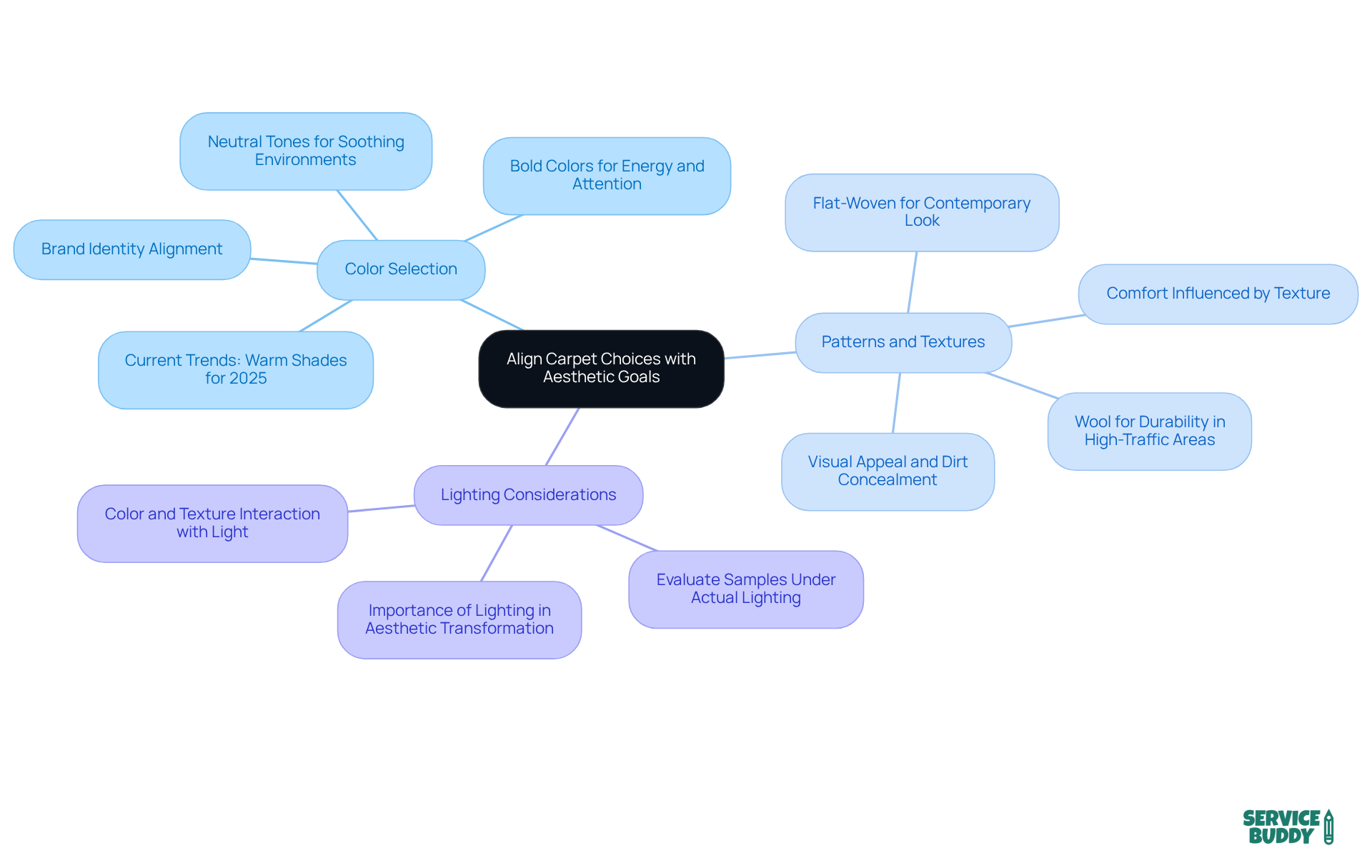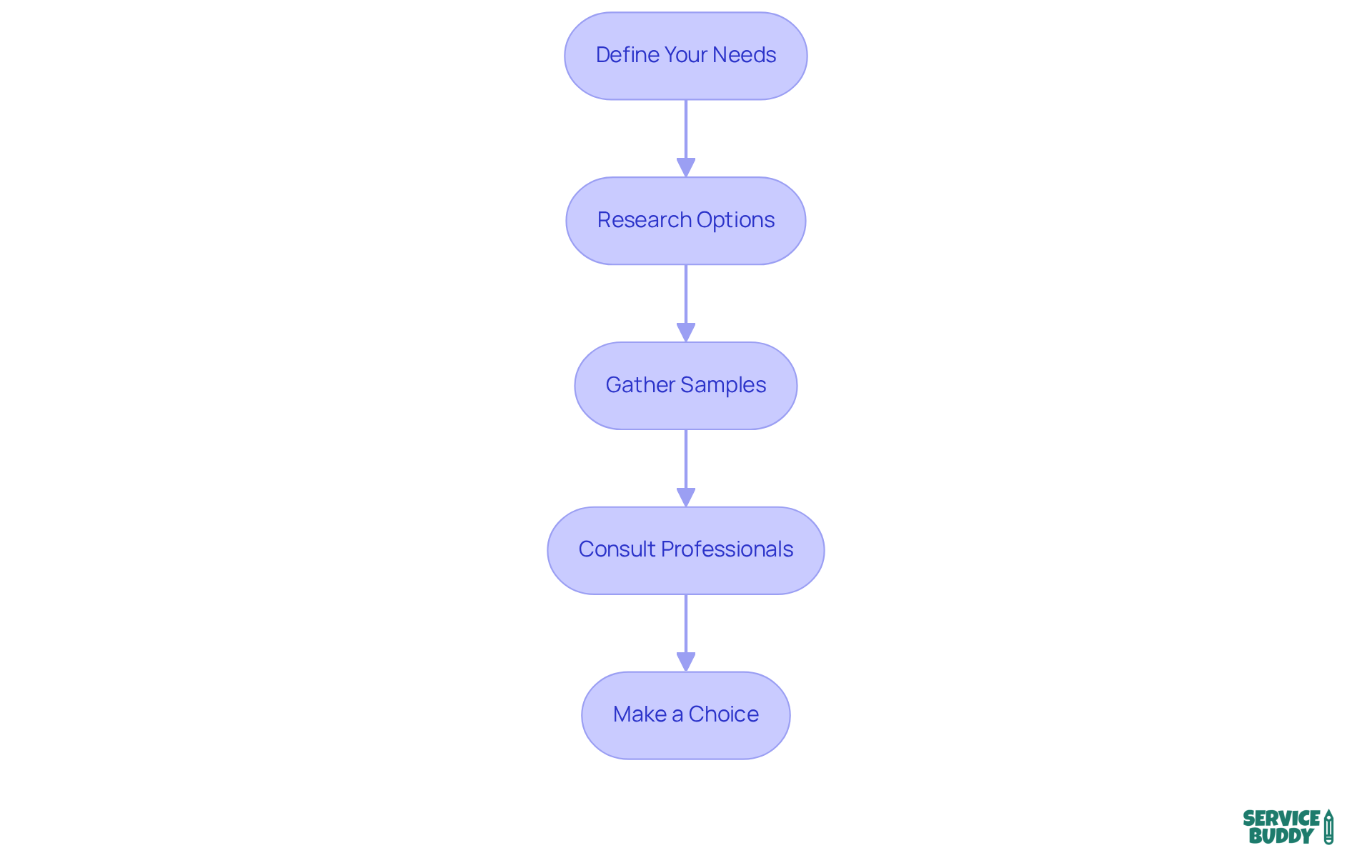Overview
Choosing the right carpeting for your business requires a structured selection process. Begin by:
- Defining your needs
- Researching options
- Gathering samples
- Consulting professionals
This methodical approach ensures that the selected carpet not only meets practical requirements—such as durability and maintenance—but also aligns with your aesthetic goals. By enhancing both the functionality and appeal of your business environment, you create a space that resonates with your brand and supports your operational objectives.
Introduction
Choosing the right carpeting for a business is more than just a design decision; it is a strategic choice that significantly impacts both aesthetics and functionality. With a diverse array of materials available—from durable nylon to luxurious wool—understanding the unique characteristics of each option is crucial for creating an inviting and efficient workspace. However, navigating the complexities of durability, maintenance, and aesthetic alignment with brand identity presents a challenge. How can businesses ensure they select the perfect carpet that meets their specific needs while enhancing their environment?
Understand Different Types of Carpets
Begin by familiarizing yourself with the diverse types of carpeting and other floor coverings available in the market. Common options include:
- Nylon: Renowned for its durability and resilience, nylon is particularly suited for high-traffic areas. According to IMARC, it is projected to maintain the largest market share in 2025 due to its exceptional durability and stain resistance.
- Polyester: This material offers a softer feel and is often more budget-friendly; however, it may not match nylon in durability. Esther Lundstrom highlights that for busy lifestyles, darker floor coverings, including polyester, are preferred as they effectively conceal dirt and debris.
- Olefin: Known for its resistance to moisture and stains, olefin is suitable for both indoor and outdoor applications, making it a versatile choice for various work environments.
- Wool: A natural fiber that exudes luxury and comfort, wool requires more maintenance. Its aesthetic appeal and insulation properties make it a favored option for upscale settings.
- Loop Pile vs. Cut Pile: Loop pile flooring is more durable and ideal for high-traffic areas, while cut pile options provide a softer feel.
Conduct thorough research on the specific characteristics of each type to ascertain which aligns best with your business's requirements and environment. Consider factors such as foot traffic, maintenance needs, and aesthetic preferences. In 2025, nylon is expected to dominate the market share in carpeting due to its durability, while polyester, olefin, and wool will also play significant roles in the carpeting landscape. Staying abreast of the , particularly for commercial applications—including advancements in manufacturing technologies and sustainability awareness—will ensure your selections reflect both functionality and style. Real-world examples of nylon versus polyester flooring in high-traffic areas can further illustrate the practical implications of choosing one material over another.

Evaluate Durability and Maintenance Needs
Assess the durability of each flooring type based on your business's specific requirements. Begin by considering the following factors:
- Traffic Levels: In high-traffic areas, the need for durable carpets is paramount. Options such as nylon or loop pile carpeting are engineered to withstand significant wear and tear. For instance, nylon carpeting is designed to endure intense foot traffic and can last 10-15 years with proper maintenance. Typically, in high-traffic zones, the lifespan of carpeting ranges from 5-7 years, underscoring the importance of durability in commercial settings.
- Maintenance Requirements: Different flooring types come with varying upkeep needs. Wool rugs, while remarkably durable and capable of lasting 15-20 years, tend to be more expensive than synthetic alternatives and necessitate every 6-12 months to retain their appearance. On the other hand, synthetic options like polyester may only require professional cleaning every 12-18 months and generally last around 7-10 years, making them a more cost-effective choice for businesses with limited maintenance resources.
- Stain Resistance: Opt for floor coverings that feature integrated stain resistance, particularly in areas prone to spills. Nylon floor coverings are well-regarded for their stain resistance and ease of cleaning, significantly reducing maintenance efforts. Furthermore, olefin floor coverings offer moisture resistance and quick drying, making them ideal for busy environments.
By understanding these critical elements, you can select carpeting that not only enhances the aesthetic appeal of your establishment but also stands the test of time, minimizing maintenance costs and fostering a welcoming atmosphere for both clients and employees.

Align Carpet Choices with Aesthetic Goals
When selecting carpeting for your business, it is essential to consider how the carpeting integrates into your overall design scheme. Here are key tips to guide your decision:
- Color Selection: Choose colors that resonate with your brand identity. Neutral tones create a soothing environment, making them ideal for offices or waiting rooms. In contrast, bold colors inject energy into a room, perfect for retail environments aiming to attract attention. Industry specialists note that wall-to-wall vibrant rugs are experiencing a resurgence as part of the maximalist style revolution, offering a chance to create striking spaces.
- Patterns and Textures: Patterns enhance visual appeal and effectively hide dirt, making them suitable for high-traffic areas. Textures contribute to comfort and can influence the overall feel of the space. For example, soft floor coverings are suggested for comfortable settings, while flat-woven alternatives provide a contemporary look. Wool rugs, known for their , are particularly appropriate for high-traffic zones, ensuring longevity and ease of upkeep.
- Lighting Considerations: Always evaluate fabric samples under your establishment's lighting conditions. Colors and textures can appear differently depending on the light, so it is crucial to see how they interact with your space before making a final decision. As noted by K. Powers & Company, understanding how color and texture can transform your space is vital for achieving the desired aesthetic.
By carefully matching your aesthetic objectives with your flooring selections, including carpeting, and considering current trends, such as the increasing preference for sustainable and durable options, you can create a harmonious and welcoming environment that enhances your establishment's attractiveness.

Follow a Structured Selection Process
To effectively choose the right carpet for your business, follow these essential steps:
- Define Your Needs: Assess the specific requirements of your space, considering factors such as foot traffic, desired aesthetics, and maintenance capabilities. Understanding these components is crucial for that satisfies both practical and aesthetic demands.
- Research Options: Investigate various carpet types and their properties, including durability, stain resistance, and design options. For instance, nylon carpeting is renowned for its exceptional strength and resilience, making it suitable for high-traffic areas, while wool carpeting offers unmatched beauty and comfort. This research will help you narrow your options to those that align with your specific needs.
- Gather Samples: Request samples of your top selections and evaluate them within your business environment. Observing how different carpets appear and feel in your space can significantly influence your decision. Consider how the color and pattern of the carpeting can enhance your brand identity and create a welcoming atmosphere for clients.
- Consult Professionals: Engage with flooring experts or interior designers to gain valuable insights. Their expertise can clarify your flooring needs, including the importance of stain-resistant features and sound-absorbing qualities, ensuring you make an informed decision that enhances your company's functionality and aesthetic appeal.
- Make a Choice: After thorough evaluation and consultation, select the flooring that best meets your requirements and aligns with your business goals. A well-chosen carpeting not only enhances the ambiance of your space but also contributes to a positive experience for both employees and customers.

Conclusion
Choosing the right carpeting for a business is a multifaceted decision that necessitates careful consideration of various factors. Understanding the different types of carpets available, evaluating their durability, maintenance needs, and aesthetic alignment with brand identity are crucial steps in ensuring a successful selection. The right carpet not only enhances the visual appeal of a space but also supports the functional requirements of a commercial environment.
Key insights emphasize the importance of selecting materials that can withstand high traffic, such as nylon or loop pile options. Additionally, it is vital to consider maintenance levels and stain resistance. Aligning carpet choices with aesthetic goals—such as color, pattern, and texture—can significantly influence the overall atmosphere of the establishment. Following a structured selection process that involves:
- Defining needs
- Researching options
- Gathering samples
- Consulting professionals
ensures a well-informed decision.
Ultimately, the significance of choosing appropriate carpeting extends beyond mere aesthetics; it contributes to creating a welcoming and functional environment for both employees and clients. By prioritizing durability, maintenance, and design, businesses can invest in flooring solutions that not only meet immediate needs but also stand the test of time, reflecting the brand's values and enhancing the customer experience.
Frequently Asked Questions
What are the main types of carpets available in the market?
The main types of carpets include nylon, polyester, olefin, and wool.
What are the characteristics of nylon carpets?
Nylon carpets are known for their durability and resilience, making them particularly suitable for high-traffic areas. They are projected to maintain the largest market share in 2025 due to their exceptional durability and stain resistance.
How does polyester compare to nylon?
Polyester offers a softer feel and is often more budget-friendly, but it may not match nylon in terms of durability. It is preferred for busy lifestyles, especially in darker colors that can conceal dirt and debris.
What are the benefits of olefin carpets?
Olefin carpets are resistant to moisture and stains, making them suitable for both indoor and outdoor applications, which adds to their versatility in various environments.
What are the advantages of wool carpets?
Wool carpets are made from natural fibers and are known for their luxury and comfort. They have aesthetic appeal and insulation properties but require more maintenance than synthetic options.
What is the difference between loop pile and cut pile carpets?
Loop pile carpets are more durable and ideal for high-traffic areas, while cut pile carpets provide a softer feel.
What factors should be considered when choosing carpet types for a business?
Factors to consider include foot traffic, maintenance needs, aesthetic preferences, and the specific characteristics of each carpet type to ensure they align with the business's requirements and environment.
What trends should be considered in the carpeting landscape?
Staying updated on trends such as advancements in manufacturing technologies and sustainability awareness is important to ensure carpet selections reflect both functionality and style.
Why is it important to research different carpet types?
Conducting thorough research helps ascertain which type of carpet best aligns with a business's needs, ensuring the selection is suitable for the intended environment and usage.




